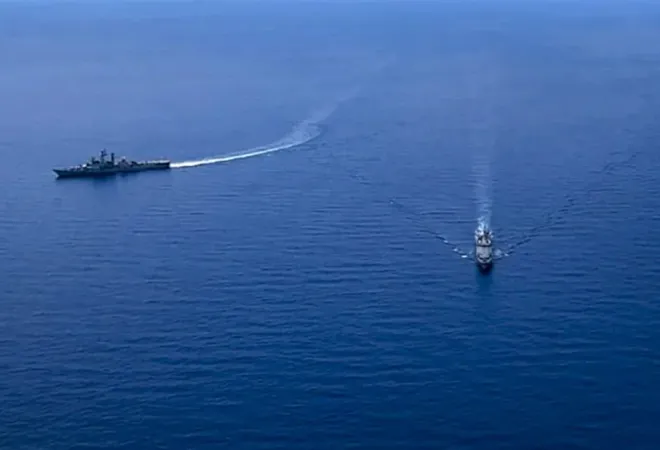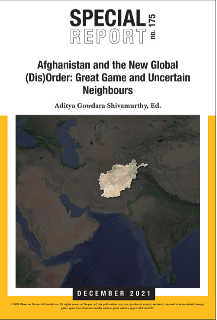
Strategic commentators often wonder how ‘
realist’ India is about cultivating and using military power. The general view is that India is uneasy with employing power politics as an instrument of statecraft. Some, however, argue that New Delhi is more ‘realist’ in its approach than many believe and more comfortable with the concept of force projection in the service of strategic interests than political observers care to acknowledge.
For a practical illustration of how India might leverage hard power for political ends, Indian observers point to the recent
India-ASEAN maritime exercise (AIME) in the South China Sea. Held between 2 May and 8 May 2023, and involving the participation of two frontline Indian warships, Satpura and Delhi, the exercise was the first instance of India conducting maritime drills with the Association of South East Asian Nations (ASEAN) partners as a bloc. Its seeming
purpose was to signal resolve to China, whose assertiveness in the South China Sea has alarmed Southeast Asian states. It was evident that this was a high-priority engagement for India because Admiral Hari Kumar, the Indian Naval Chief, was in Singapore to
flag off the exercise.
Notably, New Delhi has thus far desisted from holding multilateral military exercises with ASEAN (as a bloc). A part of the reason has been the Indian
reluctance to provoke Beijing. While India has its differences with China, Indian decision-makers largely see the South China Sea as a contested space that China dominates and where India has limited equity. That, arguably, is still the case. While India’s security posture vis-à-vis the Pacific has evolved over time—with New Delhi more willing to conduct naval operations in the Western Pacific—the cautious streak in India’s security establishment persists. Despite the elevation of India-ASEAN relations to a comprehensive strategic partnership and growing defence collaboration, New Delhi remains wary of military operations in disputed areas of the South China Sea.
It was evident that this was a high-priority engagement for India because Admiral Hari Kumar, the Indian Naval Chief, was in Singapore to flag off the exercise.
This assessment might contradict more
upbeat accounts of AIME in the media, but it isn’t without reasonable basis. The maritime exercise last week came about as a result of extensive consultations between ASEAN and India. In recent years, regular meetings held under the auspices of the ASEAN-India Dialogue Relations, the ASEAN Regional Forum (ARF), and the East Asia Summit (EAS) have helped India and ASEAN refine their agenda for military cooperation. For New Delhi, defence engagement with ASEAN is a logical extension of functional collaboration in other areas under the ‘
Act East Policy’. But India is just one of ASEAN’s many partners to witness an upgrade in the military partnership. China, the United States (US), and Russia have all held naval exercises with the Southeast Asian bloc; India is the fourth ASEAN dialogue partner to be doing such exercises.
The record of ASEAN’s military diplomacy is revealing. 2017 marked the Southeast Asian bloc’s first
multilateral naval exercise after remaining reluctant for a long time to engage militarily with extra-regional powers. It was ostensibly motivated by the belief that the association's overt focus on economic issues had diminished attention to defence issues, particularly security in the South China Sea. While ASEAN had expanded the Defence Ministers Meeting (ADMM) in 2011 to include eight new members—China, Australia, India, Japan, South Korea, New Zealand, Russia, and the US—it remained averse to combat drills with extra-regional powers. In 2018, when the Southeast Asian bloc conducted its first-ever
naval exercise, it was ironically with China, a seeming attempt by regional states to reassure Beijing that it was not an adversary but a potential partner. In 2019, the US became the second ADMM partner to hold
joint exercises with ASEAN, followed by
Russia in 2021.
For New Delhi, defence engagement with ASEAN is a logical extension of functional collaboration in other areas under the ‘Act East Policy’.
As some see it, ASEAN’s military engagements have a performative dimension; the association’s bilateral security initiatives seem intended not so much at achieving tangible outcomes but rather to demonstrate solidarity with multiple partners. Evan Lakshmana, an Indonesian expert, attributes ASEAN’s penchant for diversified engagement to a desire for balance. Southeast Asian states, he explains, recognise that the region's vexing issues call for a customised and
diverse policy toolkit. The goal of working with several partners is to solve problems in the most efficient way possible while avoiding conflict. But the desire to diversify and balance also means that ASEAN is constricted in its ability to make hard choices.
For its part, New Delhi seeks a
rules-based order in the Indo-Pacific. Indian decision-makers emphasise the need for nations to adhere to maritime law. Under the 1982 United Nations Convention on the Law of the Sea (UNCLOS), territorial disputes must be resolved peacefully, without force or the threat of violence. But India desists from taking a hard stance on China’s violation of norms in the South China Sea. As Indian officials see it, India’s naval exercises in the South China Sea serve to highlight the imperative of navigational access and high seas freedoms. They are not to challenge China’s maritime aggression or offer pushback against Beijing’s excessive territorial claims.
The pattern of the AIME was in line with this understanding. The Sea Phase of the exercise was held mainly in the exclusive economic zone of Vietnam and in international waters along the
transit route to the Philippines; participating units stayed well-clear of the disputed seas near the Spratly group of islands or Scarborough Shoal. Predictably, Chinese militia forces snooped on the formation but did not disrupt the exercises.
Under the 1982 United Nations Convention on the Law of the Sea (UNCLOS), territorial disputes must be resolved peacefully, without force or the threat of violence.
To be fair, there is more than a China dimension to India’s maritime operations in the South China Sea. India, which has long seen itself as a net-security provider in the Indian Ocean, seeks to broaden its security-provisioning role to the wider Indo-Pacific region. Indian decision-makers recognise the growing importance of the region for trade and connectivity. With over 55 percent of India’s trade passing through the South China Sea, maritime security is indeed more important for New Delhi than ever. For India, however, engaging Southeast Asia is also about cultivating a potential market for Indian
arms exports. Indian naval presence in the region is a way of burnishing New Delhi’s credentials as a reliable partner and capacity builder.
Even so, India’s purported maritime activism in the South China Sea falls short of ‘realist’ depictions. The maritime exercise last week would certainly have helped improve interoperability and integration. It may well have facilitated the fine-tuning of operational procedures and sharing of best practices. From a realpolitik lens, however, the gains appear insubstantial. Despite the showcasing of India’s and ASEAN’s tactical prowess, limiting naval manoeuvres to non-disputed regions of the South China Sea is likely to have been perceived as a concession to Chinese vanity.
Abhijit Singh is a Senior Fellow who heads the Maritime Policy Initiative at the Observer Research Foundation.
The views expressed above belong to the author(s). ORF research and analyses now available on Telegram! Click here to access our curated content — blogs, longforms and interviews.



 Strategic commentators often wonder how ‘
Strategic commentators often wonder how ‘ PREV
PREV


